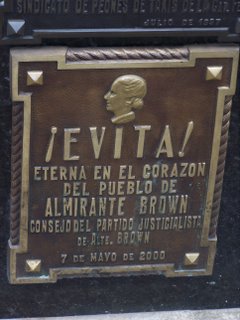
 February 3, 2006
February 3, 2006Paul is downstairs singing Esperando, a song by Café Tacuba, which he tried tirelessly to teach me as we hiked down the mule trail to visit the leper colony in Moloka’i. The 40-second song is full of important words like portón and colectivo that I’m trying to keep from shaking around in my mind so much. I feel like I forget five Spanish words for every one that I remember but my little sister, Julie, reminded me this morning that, “you are learning way more than you think.” I am trying to keep her words in my mind when I become frustrated.
The humidity was 72 percent today and I think I lost a third of my body weight in sweating. I felt all day like liquid was just pouring out of my pores faster than I could ever replace it. Yes, I’m a hot-weather wimp because I’m Scottish but California lifestyle has made my senses snooty about the cold too and I am becoming every day a little more convinced that if it’s not a balmy 72 degrees and dry, then I’ll likely have trouble adapting. Such are the toils of immigration and naturalization.
I’ve been feeling a bit weary and worn. Pico Iyer also writes in The Global Soul (talking of pubs and whorehouses and wee hour activities in Hong Kong), “I didn’t have the heart for much more of this, and as the night wore on, I knew the smiles would grow more plaintive, the ones that said, Be kind to me, please, and I’ll take good care of you bouncing against the one that said, How ever did my need bring me here?” I felt all of that today. Paul and I breakfasted in a café that appeared transplanted from the Champs Elyseé in Paris. There are times when I feel I could blink my eyes and be as easily in London or Paris. The Bar de Julio Café was wallpapered with records and old photos of canciones, none of whom I recognized. It’s pretty humbling to feel like you could be in Europe by the sight and smell of a place and realize you know absolutely nothing about its history. I drank a café con leche and ate a sandwich on a croissant while I learned that one of the singers on the wall, Carlos Gardel, was the most famous tango singer in all of Argentina. I tried to memorize his face. I added to my checklist: learn more about Argentine history. It’s right under: Climb Mount Everest. Each day I learn a little more about all that I have yet to learn.
Ten minutes later we are in the barrio Recoleta. The streets are quiet and I’m struggling to find a piece of trash where I’m usually stepping around dog shit and McDonald’s wrappers. The people are white and speak English. We walk past the Fendi store and through the shopping mall. The prices are amazing low even for Dolce and Gabana due to the weak Peso, but the store clerks still look at my Converse like I don’t belong there and I’m thinking maybe things would be different if these women got a chance to check out a town overrun by Blue Bee.
The purpose of the stroll through Recoleta is to visit the famous Cementerio where Eva Péron lies. It’s the smallest, most exclusive cemetery in the city. Even Juan Péron didn’t make the cut. In the small amount of traveling I have done, I have found cemeteries to be one of the coolest, most inexpensive ways to see the art and history of a city. The cemetery in Recoleta is no different and while it is no small potatoes to see the grave of Evita, the great thing about the day is getting to see gold and marble strewn amongst tumble-down crypts and moss-covered stones; tiny, creepy pathways and photographs of loved ones long gone.
I just started reading Chasing Ché, a book about a motorcycle trip in search of the Guevara legend by an inimitable gringo named Patrick Symmes. I bought it for Paul on his last birthday and only had to wait 8 months for him to finish it. I recommend it as an introduction both to Ché and an introduction to all the reasons motorcycles are silly and too much trouble. He visits not the cemetary in Recoleta but another, smaller, poorer cemetary in Buenos Aires. He says of the experience, “Inside the wall was the Avellaneda Municipal Cemetary, and we walked through. It was huge, but without the glamour of Recoleta where the upper classes buried their dead in elaborate, fantastical crypts that imitated Egyptian pyramide and Roman temples and Greek oracles, as if the dead were now simply confined to smaller versions of the lives they had just left.”
In a day I’ve roamed from a sidewalk café in Paris back to the snooty streets of Santa Barbara through the dusty remains of Buenos Aires and I’ve barely walked three miles. ¡Qué incredible ciudad!
1 comment:
aleta de la aleta de la aleta
palillos de la mantequilla
¡CLA PLAYA!!
¡CAMERICANOS ESTÚPIDOS! ¡CSALGA DEL AGUA!
escuche mi snot
el verde soylent se hace de la gente!! ¡es gente!
Post a Comment